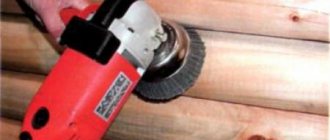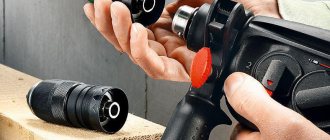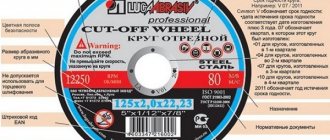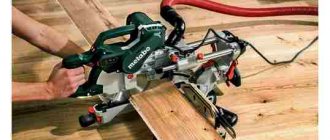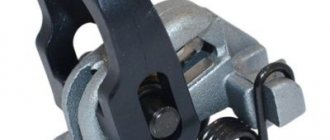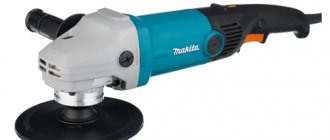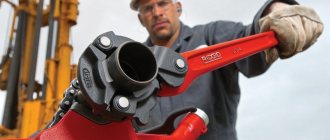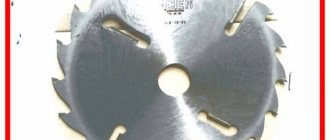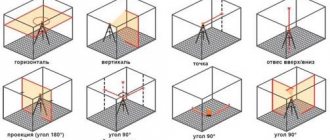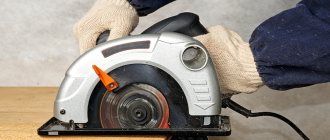When working with an angle grinder or, as we used to call it, with an angle grinder, it happens that the nut securing the disc gets clamped. In most cases this happens with abrasive metal cutting discs. This situation is familiar to many, and it cannot be called pleasant. There may be several reasons for this, but the main one is a jammed disk as a result of improper operation of the device. If you are not yet familiar with the article “How to cut correctly with a grinder,” then I recommend reading it by clicking on this link. In today’s article I will talk about how to quickly and easily unscrew a jammed nut on an angle grinder without ruining the tool and your nerves.
How not to try to unscrew a jammed nut
A jammed nut on an angle grinder is always unpleasant. This problem makes it impossible to work with the tool, and solving it takes a significant amount of time. All this affects a person’s mental state, as a result of which we begin to get nervous and perform not entirely logical actions. I want to say that there are a number of ways to unscrew a tightened nut on an angle grinder, which you shouldn’t use (well, of course, if you value your power tool and you don’t want to buy a new angle grinder soon).
- The nut has holes that serve to unscrew it using a special wrench, and also provide ventilation and prevent excessive heating. Some “comrades” insert some kind of core or pin into these holes, after which they hit it with a hammer. According to their logic, this method will help unscrew the clamped nut. Perhaps this will happen (and this is not a fact), but the load on the gearbox will be crazy - that’s for sure. The result is a quick replacement of one of the main structural elements of the angle grinder.
- A similar situation occurs when the same nut is welded on top, but larger and with edges. After that, they clamp the latch and try to unscrew it using a hefty wrench or take a large lever. The result may be a broken retainer and licked teeth on the gearbox.
- Someone is trying to heat the nut using a gas torch or cutter. This method very rarely helps, and you will definitely violate the chemical properties and strength of the metal. If you need to unscrew the nut in any way, it is easier to take another grinder and cut off two parts on opposite sides. This way she will weaken and definitely give in.
Measures to prevent jamming
By taking care of the safe operation of the angle grinder in advance, you will save yourself from the need to take measures to eliminate an emergency situation. Such events include:
- Place cardboard or plastic washers between the disk, flange and spindle head. They do not allow the tool to jam, but even in the event of a corkscrew, they can be removed/melted and the element can be easily unscrewed.
- The abrasive wheel must be installed correctly. To do this, place the front side of the circle on the support flange (with the picture facing the gearbox). It should not come into contact with the clamping nut. In this case, the standard metal ring in the center will act as a washer preventing jamming.
- Weld a regular nut onto the clamping flange, which allows you to press the installed disk using a regular wrench.
- Check the tightening force. No excessive effort is required to install the cutting element. Otherwise, it will jam under intense loads.
A simple way to unscrew a jammed nut
Now, let's look at the most gentle way to unscrew a tight nut on an angle grinder. I will not say that this method is a panacea for such a problem, but of all the existing possibilities it is the most optimal.
First, you need to find a piece of metal up to 1 mm thick. I recommend taking a plate that will be even thinner, about 0.8 mm.
It must be clamped in a choke. The dimensions of this product do not play a special role. Take whatever is at hand. The main parameter is thickness. If you take metal thicker than 1 mm, then nothing will work.
Next you need to break off the remaining disk. Most likely, a piece of it flew off anyway. To do this, you can use your hands or regular pliers. It is necessary that one nut remains, and the remains of the disk are not visible.
You should get it like in the photo. Only a small part of the abrasive disk remains, which is sandwiched between two nuts. We need to extract it too.
Next, you need to very carefully insert the metal plate between the two nuts, where we have a piece of disk left. So let's start cutting. Now you understand why the metal must be thinner than the disk itself, clamped in the grinder.
After some time, the remains of the disk are simply worn off. You will feel this immediately, after which you need to turn off the grinder.
After performing such manipulations, the nut on the angle grinder can be unscrewed even by hand. It is very important to clamp the sheet of metal in a vice. Do not hold it in your hand under any circumstances. The most important thing is safety precautions. Yes, and during this process the nut gets very hot, take this into account.
ATTENTION!!!
If you want to learn more about woodworking tools and the crafts you can make with them, be sure to check out this link.
Safety regulations
When working with an angle grinder, it is important to remember that this tool has an increased risk of injury. Accordingly, you should not lose vigilance under any circumstances, even when disconnected from the power supply. When using auxiliary tools and materials to replace the disk, pay close attention to them. Plumber tools can also cause significant injury.
An angle grinder (angle grinder) or grinder has proven itself to be a very effective tool with which you can perform a wide range of work. However, during its operation, you should adhere to safety precautions, since the disk speeds are very high and you can get injured. Judging by numerous reviews, many home craftsmen have problems with the discs; they often split, and the nuts with which they are clamped become jammed. The reason for this may be the human factor or simply marriage. As a result, such a nozzle cannot be used for its intended purpose.
It would seem that there is nothing difficult about replacing the disk with a new one. However, at this stage the master is faced with a problem - the nozzle is tightly clamped by a fixing nut that does not want to unscrew. How to remove a jammed disc from an angle grinder? What methods are used for this? What means can be used if the standard key is lost? You will learn how to remove a jammed disc from an angle grinder from this article.
Read also: How to calculate electricity consumption based on the power of the device
How to prevent the nut from jamming on an angle grinder
It is quite possible to unscrew a tightened nut on an angle grinder, but it is better to prevent such a problem from occurring. Of course, you can try to work the angle grinder extremely carefully and simply prevent the disc from jamming and rupturing. But we are all human and often make mistakes.
There are a number of special nuts that can be easily unscrewed in the event of a clamp. Their cost is about 200 rubles. You can view this product using this link https://got.by/371i3w.
In addition, you can buy a special gasket that is placed between the disk and the clamping nut. Its price is only 70 rubles, you can buy it using this link https://ali.pub/371iel. You can make this gasket yourself by cutting it out of paranit or regular newspaper.
How to remove a bitten disc from an angle grinder + (Video)
The use of new nuts solves the problem of removing the disk, but what to do with an already bitten disk? Even if the disk was installed correctly, it is not always possible to remove it. Practice suggests different ways to solve a problem. You can clamp the clamp and hit the nut holes through the extension in the direction of unwinding. This option is only possible with a working latch. But the latch may not withstand such a solution to the problem and break.
The second method is more logical. Under the clamping nut and lower support washer there is a gearbox shaft with machined chamfers. The lower support washer is put on them. A standard wrench cannot be installed there - it is very narrow. But you can take a regular open-end wrench set to “17” and sharpen it on both sides.
The turned key will fit into the gap, fit onto the chamfer of the shaft and secure it. Now, using any wrench, any nut will be unscrewed, and the disk or its remains will be removed from the angle grinder.
Bottom line
I hope my article today was clear and useful. Now you know how to quickly and easily unscrew a tightened nut on an angle grinder. The most important thing is to be careful and not give in to emotions. It’s better to think twice than to buy a new power tool or spend money on repairs.
If you are not yet familiar with my colleague’s article “ Wooden toilet in a private house” , then you can read it at this link .
Write in the comments how often do you tighten the nut on your grinder?
What to do if the nut is stuck?
A common problem when operating an angle grinder is a jammed nut. The first thing to do in such a situation is to determine the direction of rotation of the disk. It is recommended to unscrew the jammed nut in the same direction. There are several most effective ways to solve this problem.
- Use an open-end wrench and a socket head. To do this, it is necessary to grind off the surface of the open-end wrench by 4 millimeters, which is 17 millimeters. On the head of the 24 mm end, grind four protrusions that will align with the holes of the flange nut. The open-end wrench is then positioned under the disc and the socket head is placed on the nut of the angle grinder. After this, the ratchet should be turned in the direction of rotation of the disk.
- Use the gas key. Knowing the laws of physics and using a gas wrench, you can increase the moment of force, as the length of the arm increases.
- Use a hammer drill. If you set the hammer drill to the chiselling mode without the rotation function, it will work on the principle of a jackhammer. A six-millimeter drill is placed on the flange end and work begins. After the nut moves, it can be easily unscrewed with a special wrench for an angle grinder.
- Warming up. If you heat the nut with a technical hair dryer or a gas torch, the metal will become more pliable. All you have to do is unscrew the nut with a wrench. But during the heating process, you need to be careful not to damage the plastic parts and gearbox.
- Disc breaking is an easy and quick way to unscrew a stuck nut without a wrench. It involves complete crumbling of the disk. For this purpose, you should use a hacksaw or pliers. When only the inner ring remains of the abrasive wheel, clamp the unnecessary metal plate in a vice (its thickness should not exceed the thickness of the disk). Next, you need to start the angle grinder and grind the abrasive down to the landing sleeve. Remember to use safety glasses and gloves when doing this. Then all that remains is to unscrew the flange nut by hand.
